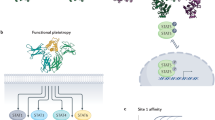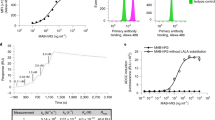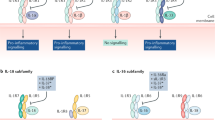Abstract
Success achieved so far in the blockade of tumor necrosis factor and interleukin (IL)-1 in rheumatoid arthritis exemplifies the feasibility and potential therapeutic application of antagonizing cytokine signaling. Despite these advances, there remains a considerable unmet clinical need in this field. A number of preclinical development programs are ongoing to target a variety of cytokines that are central to immune regulation and tissue-matrix destruction in rheumatoid arthritis. Evidence indicates that IL-6 antagonists might represents a useful approach and preliminary data similarly identify IL-15 as an intriguing target. Numerous additional cytokines are under investigation at the preclinical stage, including IL-12–IL-23, IL-17 and IL-18. As therapeutic goals move from disease control towards remission induction, development of the capacity for cytokine targeting to modify the underlying immune dysregulation remains a major priority.
Key Points
-
Tumor necrosis factor blockade is effective in improving clinical signs and symptoms in rheumatoid arthritis (RA) patients and can ameliorate radiographic damage
-
Patient subsets that do not respond to tumor necrosis factor blockade, or respond only partially, represent an unmet clinical need
-
Numerous cytokine activities have now been described in RA synovia and studies in mouse arthritis models provide rational for their neutralization in clinical trials
-
Interleukin (IL)-6 and IL-15 are currently being tested in clinical studies in human RA
-
Preclinical evidence suggests that IL-12–IL-23, IL-18 and IL-17 might also offer therapeutic potential
-
Novel cytokine targets, including high mobility group box 1 protein and adipokines, might offer future therapeutic utility
This is a preview of subscription content, access via your institution
Access options
Subscribe to this journal
Receive 12 print issues and online access
$209.00 per year
only $17.42 per issue
Buy this article
- Purchase on Springer Link
- Instant access to full article PDF
Prices may be subject to local taxes which are calculated during checkout



Similar content being viewed by others
References
Feldmann M and Maini RN (2001) Anti-TNF alpha therapy of rheumatoid arthritis: what have we learned? Annu Rev Immunol 19: 163–196
van Jaarsveld CH et al. (1999) The prognostic value of the antiperinuclear factor, anti-citrullinated peptide antibodies and rheumatoid factor in early rheumatoid arthritis. Clin Exp Rheumatol 17: 689–697
Brennan FM et al. (1989) Inhibitory effect of TNF alpha antibodies on synovial cell interleukin-1 production in rheumatoid arthritis. Lancet 2: 244–247
Klareskog L et al. (2004) Therapeutic effect of the combination of etanercept and methotrexate compared with each treatment alone in patients with rheumatoid arthritis: double-blind randomized controlled trial. Lancet 363: 675–681
Nishimoto N et al. (2000) Anti-interleukin 6 receptor antibody treatment in rheumatic disease. Ann Rheum Dis 59 (Suppl 1): i21–i27
Alonzi T et al. (1998) Interleukin 6 is required for the development of collagen-induced arthritis. J Exp Med 187: 461–468
Takagi N et al. (1998) Blockage of interleukin-6 receptor ameliorates joint disease in murine collagen-induced arthritis. Arthritis Rheum 41: 2117–2121
Choy EH et al. (2002) Therapeutic benefit of blocking interleukin-6 activity with an anti-interleukin-6 receptor monoclonal antibody in rheumatoid arthritis: a randomized, double-blind, placebo-controlled, dose-escalation trial. Arthritis Rheum 46: 3143–3150
Nakahara H et al. (2003) Anti-interleukin-6 receptor antibody therapy reduces vascular endothelial growth factor production in rheumatoid arthritis. Arthritis Rheum 48: 1521–1529
Nishimoto N et al. (2004) Treatment of rheumatoid arthritis with humanized anti-interleukin-6 receptor antibody: a multicenter, double-blind, placebo-controlled trial. Arthritis Rheum 50: 1761–1769
Yokota S et al. (2005) Therapeutic efficacy of humanized recombinant anti-interleukin-6 receptor antibody in children with systemic-onset juvenile idiopathic arthritis. Arthritis Rheum 52: 818–825
Pelletier JP and Martel-Pelletier J (2003) Oncostatin M: foe or friend? Arthritis Rheum 48: 3301–3303
Hui W et al. (2003) Oncostatin M in combination with tumor necrosis factor alpha induces cartilage damage and matrix metalloproteinase expression in vitro and in vivo. Arthritis Rheum 48: 3404–3418
Hui W et al. (2005) A model of inflammatory arthritis highlights a role for oncostatin M in pro-inflammatory cytokine-induced bone destruction via RANK/RANKL. Arthritis Res Ther 7: R57–R64
Waldmann TA and Tagaya Y (1999) The multifaceted regulation of interleukin-15 expression and the role of this cytokine in NK cell differentiation and host response to intracellular pathogens. Annu Rev Immunol 17: 19–49
Budagian V et al. (2004) Reverse signaling through membrane-bound interleukin-15. J Biol Chem 279: 42192–42201
Dubois S et al. (2002) IL-15Rα recycles and presents IL-15 in trans to neighboring cells. Immunity 17: 537–547
McInnes IB et al. (2003) New strategies to control inflammatory synovitis: interleukin 15 and beyond. Ann Rheum Dis 62: 51–54
McInnes IB et al. (1997) Interleukin-15 mediates T cell-dependent regulation of tumor necrosis factor-α production in rheumatoid arthritis. Nat Med 3: 189–195
Ruchatz H et al. (1998) Soluble IL-15 receptor alpha-chain administration prevents murine collagen-induced arthritis: a role for IL-15 in development of antigen-induced immunopathology. J Immunol 160: 5654–5660
Ferrari-Lacraz S et al. (2004) Targeting IL-15 receptor-bearing cells with an antagonist mutant IL-15/Fc protein prevents disease development and progression in murine collagen-induced arthritis. J Immunol 173: 5818–5826
Baslund B et al. (2005) Targeting interleukin-15 in patients with rheumatoid arthritis: a proof-of-concept study. Arthritis Rheum 52: 2686–2692
McInnes IB et al. (2004) Safety and efficacy of a human monoclonal antibody to IL-15 (AMG 714) in patients with rheumatoid arthritis (RA): results from a multicenter, randomized, double-blind, placebo-controlled trial [abstract]. Arthritis Rheum 50 (Suppl): a241
Zheng XX et al. (2003) Favorably tipping the balance between cytopathic and regulatory T cells to create transplantation tolerance. Immunity 19: 503–514
Schulze-Koops H and Kalden JR (2001) The balance of Th1/Th2 cytokines in rheumatoid arthritis. Best Pract Res Clin Rheumatol 15: 677–691
Veys EM et al. (1997) A randomized, double-blind study comparing twenty-four-week treatment with recombinant interferon-gamma versus placebo in the treatment of rheumatoid arthritis. Arthritis Rheum 40: 62–68
Sigidin YA et al. (2001) Randomized, double-blind trial of anti-interferon-gamma antibodies in rheumatoid arthritis. Scand J Rheumatol 30: 203–207
Kolls JK and Linden A (2004) Interleukin-17 family members and inflammation. Immunity 21: 467–476
Chabaud M et al. (1999) Human interleukin-17: a T cell-derived proinflammatory cytokine produced by the rheumatoid synovium. Arthritis Rheum 42: 963–970
Lubberts E et al. (2005) The role of T cell interleukin-17 in conducting destructive arthritis: lessons from animal models. Arthritis Res Ther 7: 29–37
Gracie JA et al. (2003) Interleukin-18. J Leukoc Biol 73: 213–224
Gracie JA et al. (1999) A proinflammatory role for IL-18 in rheumatoid arthritis. J Clin Invest 104: 1393–1401
Rooney T et al. (2004) Synovial tissue interleukin-18 expression and the response to treatment in patients with inflammatory arthritis. Ann Rheum Dis 63: 1393–1398
Joosten LA et al. (2004) Interleukin-18 promotes joint inflammation and induces interleukin-1-driven cartilage destruction. Am J Pathol 165: 959–967
Wei XQ et al. (2001) Reduced incidence and severity of collagen-induced arthritis in mice lacking IL-18. J Immunol 166: 517–521
Plater-Zyberk C et al. (2001) Therapeutic effect of neutralizing endogenous IL-18 activity in the collagen-induced model of arthritis. J Clin Invest 108: 1825–1832
Smeets RL et al. (2003) Adenoviral delivery of IL-18 binding protein C ameliorates collagen-induced arthritis in mice. Gene Ther 10: 1004–1011
Morita Y et al. (1998) Expression of interleukin-12 in synovial tissue from patients with rheumatoid arthritis. Arthritis Rheum 41: 306–314
Hess H et al. High doses of interleukin-12 inhibit the development of joint disease in DBA/1 mice immunized with type II collagen in complete Freund's adjuvant. Eur J Immunol 26: 187–191
Leung BP et al. (2000) Combined effects of IL-12 and IL-18 on the induction of collagen-induced arthritis. J Immunol 164: 6495–6502
Malfait AM et al. (1998) Blockade of IL-12 during the induction of collagen-induced arthritis (CIA) markedly attenuates the severity of the arthritis. Clin Exp Immunol 111: 377–383
Joosten LA et al. (1997) Dual role of IL-12 in early and late stages of murine collagen type II arthritis. J Immunol 159: 4094–4102
Butler DM et al. (1999) Anti-IL-12 and anti-TNF antibodies synergistically suppress the progression of murine collagen-induced arthritis. Eur J Immunol 29: 2205–2212
Joosten LA et al. (2002) Local interleukin-12 gene transfer promotes conversion of an acute arthritis to a chronic destructive arthritis. Arthritis Rheum 46: 1379–1389
Trinchieri G et al. (2003) The IL-12 family of heterodimeric cytokines: new players in the regulation of T cell responses. Immunity 19: 641–644
Murphy CA et al. (2003) Divergent pro- and anti-inflammatory roles for IL-23 and IL-12 in joint autoimmune inflammation. J Exp Med 198: 1951–1957
Goldberg R et al. (2004) Suppression of ongoing adjuvant-induced arthritis by neutralizing the function of the p28 subunit of IL-27. J Immunol 173: 1171–1178
Kauffman CL et al. (2004) A phase I study evaluating the safety, pharmacokinetics, and clinical response of a human IL-12 p40 antibody in subjects with plaque psoriasis. J Invest Dermatol 123: 1037–1044
Sattar N et al. (2003) Explaining how “high-grade” systemic inflammation accelerates vascular risk in rheumatoid arthritis. Circulation 108: 2957–2963
Schaffler A et al. (2003) Adipocytokines in synovial fluid. JAMA 290: 1709–1710
Bokarewa M et al. (2005) Resistin, an adipokine with potent proinflammatory properties. J Immunol 174: 5789–5795
Kokkola R et al. (2002) High mobility group box chromosomal protein 1: a novel proinflammatory mediator in synovitis. Arthritis Rheum 46: 2598–2603
Kokkola R et al. (2003) Successful treatment of collagen-induced arthritis in mice and rats by targeting extracellular high mobility group box chromosomal protein 1 activity. Arthritis Rheum 48: 2052–2058
Bekker PJ et al. (2004) A single-dose placebo-controlled study of AMG 162, a fully human monoclonal antibody to RANKL, in postmenopausal women. J Bone Miner Res 19: 1059–1066
Tan SM et al. (2003) Local production of B lymphocyte stimulator protein and APRIL in arthritic joints of patients with inflammatory arthritis. Arthritis Rheum 48: 982–992
Dinarello CA (2005) Blocking IL-1 in systemic inflammation. J Exp Med. 201: 1355–1359
Cohen SB (2004) The use of anakinra, an interleukin-1 receptor antagonist, in the treatment of rheumatoid arthritis. Rheum Dis Clin North Am 30: 365–380
Choe JY et al. (2003) Interleukin 1 receptor dependence of serum transferred arthritis can be circumvented by toll-like receptor 4 signaling. J Exp Med 197: 537–542
Acknowledgements
The authors acknowledge funding support from the Arthritis Research Campaign and The Wellcome Trust (UK).
Author information
Authors and Affiliations
Corresponding author
Ethics declarations
Competing interests
The authors declare no competing financial interests.
Rights and permissions
About this article
Cite this article
McInnes, I., Liew, F. Cytokine networks—towards new therapies for rheumatoid arthritis. Nat Rev Rheumatol 1, 31–39 (2005). https://doi.org/10.1038/ncprheum0020
Received:
Accepted:
Issue Date:
DOI: https://doi.org/10.1038/ncprheum0020
This article is cited by
-
Peptide Derivatives of Human and Rabbit Cathelicidin Reduce Inflammatory Cytokines in Peripheral Blood Mononuclear Cells of Rheumatoid Arthritis Patients
International Journal of Peptide Research and Therapeutics (2024)
-
Circadian rhythms affect bone reconstruction by regulating bone energy metabolism
Journal of Translational Medicine (2021)
-
Identification of circular RNAs hsa_circ_0140271 in peripheral blood mononuclear cells as a novel diagnostic biomarker for female rheumatoid arthritis
Journal of Orthopaedic Surgery and Research (2021)
-
The role of IL-18 in addition to Th17 cytokines in rheumatoid arthritis development and treatment in women
Scientific Reports (2021)
-
Orchestrated modulation of rheumatoid arthritis via crosstalking intracellular signaling pathways
Inflammopharmacology (2021)



